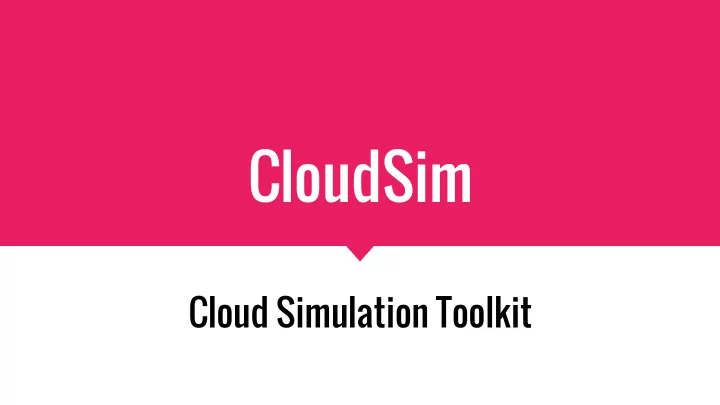

CloudSim Cloud Simulation Toolkit
Agenda Introduction - Cloud Computing & Cloudsim. ● Essentials to start with Cloudsim. ● Insight on Cloudsim modeled components. ● Insight on Cloudsim simulation process. ● Hands-on examples. ●
Introduction - Cloud Computing Service Stack
Cloud Infrastructure Challenges for researchers Cloud exhibit varying demands, supply patterns, system ● sizes and resources. Users have heterogeneous, dynamic and competing QoS ● requirements. Applications have varying performance, workload and ● dynamic application scaling requirements. due to third party ownership,no flexibility on ● configuration and cost. re-producing reliable results and benchmarking is extremely difficult.
Cloudsim - a viable alternative Hasslefree extensible modeling and event based simulation ● of large scale cloud infrastructure with support of virtualization engine. Self contained platform for modeling: ● Clouds, ○ Service brokers ○ Provisioning and allocation policies. ○ Flexibility to switch between: ● Space-shared ○ Time-shared allocation, at all the levels. ○ simulation of network connections among the simulated ● systems elements. Support for federated cloud environment. ●
Cloudsim - Essentials JDK 1.6 or above http://tinyurl.com/JNU-JAVA ● Eclipse 4.2 or above http://tinyurl.com/JNU-Eclipse ● Alternatively NetBeans https://netbeans.org/downloads ● Up & Running with cloudsim guide: https://goo.gl/TPL7Zh ●
Cloudsim-Directory structure cloudsim/ -- top level CloudSim directory ● docs/ -- CloudSim API Documentation ● examples/ -- CloudSim examples ● jars/ -- CloudSim jar archives ● sources/ -- CloudSim source code ●
Cloudsim - Layered Architecture
Cloudsim - Time/Space shared models (a)VM-space,Task-space (b)VM-space,Task-time (c)VM-time,Task-space (a)VM-time,Task-time
Cloudsim - Network latency matrix using BRITE E ij = Delay from entity i to entity j
Cloudsim - Network latency behavior
Components of Virtualized Infrastructure
Cloudsim - Component model classes CloudInformationService.java ● Datacenter.java,Host.java,Pe.java ● Vm.java,Cloudlet.java ● DatacenterBroker.java ● Storage.java,HarddriveStorage.java, SanStorage.java ●
Cloudsim - Major blocks/Modules org.cloudbus.cloudsim ● org.cloudbus.cloudsim.core ● org.cloudbus.cloudsim.core.predicates ● org.cloudbus.cloudsim.distributions ● org.cloudbus.cloudsim.lists ● org.cloudbus.cloudsim.network ● org.cloudbus.cloudsim.network.datacenter ● org.cloudbus.cloudsim.power ● org.cloudbus.cloudsim.power.lists ● org.cloudbus.cloudsim.power.models ● org.cloudbus.cloudsim.provisioners ● org.cloudbus.cloudsim.util ●
Cloudsim - key components Datacenter CloudInformationService ● ● DataCenterCharacteristics CloudSim ● ● Host CloudSimTags ● ● DatacenterBroker SimEvent ● ● RamProvisioner SimEntity ● ● BwProvisioner CloudsimShutdown ● ● Storage FutureQueue ● ● Vm DefferedQueue ● ● VMAllocationpolicy Predicate and associative ● ● VmScheduler classes. ● Cloudlet ● CloudletScheduler ●
Ok … so how exactly this system works?
Simulation flow for basic scenario
Cloudsim - Core simulation framework
Task execution Queue management
Cloudsim - General steps to follow Initiate the cloudsim simulation. ● create a datacenter. ● create a datacenter broker. ● create VMs/cloudlet add it to respective lists. ● submit vm and cloudlet list to borker. ● start simulation. ● stop simulation. ● print the end results. ●
To Work on Cloudsim only thing you require is to know Computers cannot think for themselves or assume anything. They can do exactly what you tell them to do. So think like a programmer and model your work in Cloudsim
Cloudsim - Quick look inside
Cloudsim - Q & A @anupinder ● anupindersingh@superwits.com ● Share your feedback at: ● http://tinyurl.com/CloudSimJNUDec16
Recommend
More recommend